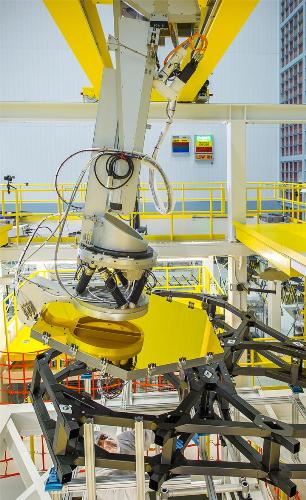Jan 28 2016
Inside a massive clean room at NASA's Goddard Space Flight Center in Greenbelt, Maryland the James Webb Space Telescope team is steadily installing the largest space telescope mirror ever. Unlike other space telescope mirrors, this one must be pieced together from segments using a high-precision robotic arm.
 A robotic arm called the Primary Mirror Alignment and Integration Fixture is used to lift and lower each of Webb's 18 primary flight mirror segments to their locations on the telescope structure. Credit: NASA/Chris Gunn
A robotic arm called the Primary Mirror Alignment and Integration Fixture is used to lift and lower each of Webb's 18 primary flight mirror segments to their locations on the telescope structure. Credit: NASA/Chris Gunn
The team uses a robotic arm called the Primary Mirror Alignment and Integration Fixture to lift and lower each of Webb's 18 primary flight mirror segments to their locations on the telescope structure. Each of the mirrors is made with beryllium, chosen for its properties to withstand the super cold temperatures of space. Each segment also has a thin gold coating to reflect infrared light. These mirror segments will function as one when the telescope is in orbit.
“In order for the combination of mirror segments to function as a single mirror they must be placed within a few millimeters of one another, to fraction-of-a-millimeter accuracy. A human operator cannot place the mirrors that accurately, so we developed a robotic system to do the assembly," said NASA's James Webb Space Telescope Program Director Eric Smith, at Headquarters in Washington.
To precisely install the segments, the robotic arm can move in six directions to maneuver over the telescope structure. While one team of engineers maneuvers the robotic arm, another team of engineers simultaneously takes measurements with lasers to ensure each mirror segment is placed, bolted and glued perfectly before moving to the next.
"While the team is installing the mirrors there are references on the structure and the mirrors that allow the team to understand where the final mirror surface is located," said Harris Corporation's James Webb Space Telescope's Assembly Integration and Test Director Gary Matthews Greenbelt, Maryland.
The team uses reference points on the telescope structure called Spherically Mounted Retroreflectors to accomplish this feat. A laser tracker, similar to the ones used by surveyors, looks at those reference points and can determine where the mirror segments go.
"Instead of using a measuring tape, a laser is used to measure distance very precisely," said Matthews. "Based off of those measurements a coordinate system is used to place each of the primary mirror segments. The engineers can move the mirror into its precise location on the telescope structure to within the thickness of a piece of paper."
Harris Corporation engineers are helping build NASA's ultra-powerful James Webb Space Telescope. Harris is responsible for integrating components made by various members of the team to form the optical telescope element, which is the portion of the telescope that will collect light and provide sharp images of deep space.
The James Webb Space Telescope is the scientific successor to NASA's Hubble Space Telescope. It will be the most powerful space telescope ever built. Webb is an international project led by NASA with its partners, the European Space Agency and the Canadian Space Agency.
For more information about NASA's Webb telescope, visit:www.nasa.gov/webb or jwst.nasa.gov
Laura Betz
NASA Goddard Space Flight Center